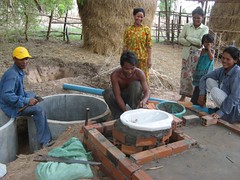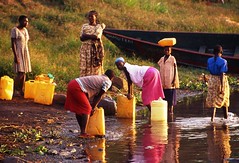 聯合國兒童基金會(UNICEF)和世界衛生組織(WHO)6日發表報告指出,當今將近90%的人能夠享有乾淨且安全的飲用水。
聯合國兒童基金會(UNICEF)和世界衛生組織(WHO)6日發表報告指出,當今將近90%的人能夠享有乾淨且安全的飲用水。
在聯合國千禧年發展目標(Millennium Development Goals,MDG)的環境永續發展目標(Environmental Sustainability Goal)中,承諾在西元2015年前致力於將無法享用安全飲用水的人口比例減半。而根據新的統計,此目標已實現。
自西元1990到2010年間,超過20億的人口取得途徑以改善飲用水的資源,像是管道供水及受保護的水井。到了2010年,全世界89%的人口、意即61億的人口享有經改善的水資源,此數字已超過原本目標所訂的88%。
 「今天,我們讚賞一項造福全球人類的偉大成就。」聯合國秘書長潘基文表示:「這是千禧年發展目標中所達到的第一項。」聯合國致力於提供人們更佳的飲用水取得途徑。許多人並不認為「千禧年發展目標」只是個遙不可及的夢想;對他們來說,這是改善數以百萬計的極貧人口生活至關重要的作法。而此次的成功對他們人來說已成為最佳例證。
「今天,我們讚賞一項造福全球人類的偉大成就。」聯合國秘書長潘基文表示:「這是千禧年發展目標中所達到的第一項。」聯合國致力於提供人們更佳的飲用水取得途徑。許多人並不認為「千禧年發展目標」只是個遙不可及的夢想;對他們來說,這是改善數以百萬計的極貧人口生活至關重要的作法。而此次的成功對他們人來說已成為最佳例證。
3月6日, 世界衛生組織和聯合國兒童基金的「水資源供應暨衛生聯合監督計畫」發表了新報告《2012年飲用水及衛生進展》(Progress on Drinking Water and Sanitation 2012)。報告指出,在目標所訂的2015年之前,全球92%的人口將能享有經改善的飲用水。
WHO 總幹事陳馮富博士表示:「為減少疾病的發生,提供永續方法以改善飲用水資源是我們所能做最重要的事情之一。然而,今天的成就只是起點。我們必定要繼續確保水資源途徑的安全性,否則今日的成果將是枉然。」
「這對孩童來說更是好消息。」聯合國兒童基金會執行主任安東尼萊克(Anthony Lake)表示:「全球每天有超過3000位孩童死於腸道感染。而此次目標的達成能拯救許多孩童的生命。」
 萊克也警告,全球至少有11%的人口,也就是7億8300萬的人口仍然沒有取得飲用水的途徑,更有數十億的人口無法享有衛生設備。
萊克也警告,全球至少有11%的人口,也就是7億8300萬的人口仍然沒有取得飲用水的途徑,更有數十億的人口無法享有衛生設備。
千禧年發展目標中的衛生項目目前離目標仍有一段路要走,在西元2015年之前仍不可能達成。此報告也指出,目前有25億人口缺乏衛生條件的改善。
目前,全球有63%的人口能享有更佳的衛生基礎建設,此比例預計在西元2015年前增加至67%,但仍低於千禧年發展目標鎖定的75%。
在撒哈拉以南的非洲地區,只有61%的人口享有經改善的水資源;而在拉丁美洲、加勒比海地區、北非及亞洲大部分地區則高達90%。
 全球缺乏安全飲用水取得途徑的總人口中,超過40%的人口居住於撒哈拉以南的非洲地區。
全球缺乏安全飲用水取得途徑的總人口中,超過40%的人口居住於撒哈拉以南的非洲地區。
在最低度發展國家(Least Developed Countries,LDCs)中,每100人就有97人無法享有管道供水,且這些人口中有14%的人們喝的是來自河流、池塘或是湖泊的地表水。
全球有11億的人口仍使用露天廁所,其中絕大部分在鄉下地區生活。舉例來說,拉丁美洲及加勒比海地區有17%的鄉下人口露天如廁,而北非則有9%。
研究發現,即使在經濟急速成長金磚四國(BRIC),仍有非常多人無法取得更佳的衛生設備,其中印度有6億2600萬人、中國有1400萬人,巴西則有7200萬人。
Close to nine out of every 10 people in the world now has access to clean, safe drinking water, finds a report issued today by UNICEF and the World Health Organization.
The new statistic means that the world has achieved the Millennium Development Goal of halving the proportion of people without access to safe drinking water in advance of the 2015 deadline. The safe drinking water target is part of the Environmental Sustainability Goal.
Between 1990 and 2010, more than two billion people gained access to improved drinking water sources, such as piped supplies and protected wells. By 2010, 89 percent of the world's population, or 6.1 billion people, used improved drinking water sources, exceeding the target of 88 percent.
"Today we recognize a great achievement for the people of the world," said UN Secretary-General Ban Ki-moon. "This is one of the first MDG (Millennium Development Goals) targets to be met. The successful efforts to provide greater access to drinking water are a testament to all who see the Millennium Development Goals not as a dream, but as a vital tool for improving the lives of millions of the poorest people."
The new report, "Progress on Drinking Water and Sanitation 2012," issued today by the WHO/UNICEF Joint Monitoring Programme for Water Supply and Sanitation, says that by the target date of 2015, 92 percent of the global population will have access to improved drinking water.
"Providing sustainable access to improved drinking water sources is one of the most important things we can do to reduce disease," said WHO Director-General Dr. Margaret Chan. "But this achievement today is only the beginning. We must continue to ensure this access remains safe. Otherwise our gains will be in vain."
"For children this is especially good news," said UNICEF Executive Director Anthony Lake. "Every day more than 3,000 children die from diarrhoeal diseases. Achieving this goal will go a long way to saving children's lives."
Lake warned that at least 11 percent of the world's population, 783 million people, are still without access to safe drinking water, and billions are still without sanitation facilities.
The world is still far from meeting the Millennium Development Goal target for sanitation, and is unlikely to do so by the target date of 2015. Currently 2.5 billion people lack improved sanitation, the report shows.
Only 63 percent of the world's people now have improved sanitation access, a figure projected to increase to 67 percent by 2015. But that figure is still well below the 75 percent MDG target.
Only 61 percent of the people in sub-Saharan Africa have access to improved water supply sources compared with 90 percent or more in Latin America and the Caribbean, Northern Africa, and large parts of Asia.
Over 40 percent of all people globally who lack access to safe drinking water live in sub-Saharan Africa.
In the rural areas of Least Developed Countries, 97 out of every 100 people do not have piped water and 14 percent of the population drinks surface water from rivers, ponds, or lakes.
Of the 1.1 billion people who still practice open defecation, the vast majority live in rural areas. For instance, 17 percent of rural dwellers in Latin America and the Caribbean and nine percent in Northern Africa still resort to this practice.
Even the BRIC countries, with rapidly growing economies, have large numbers of people without access to improved sanitation: 626 million in India, 14 million in China, and 7.2 million in Brazil, the report finds.


